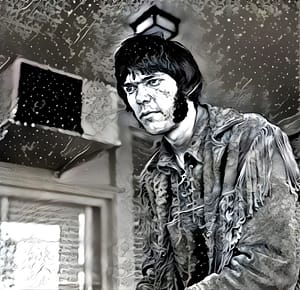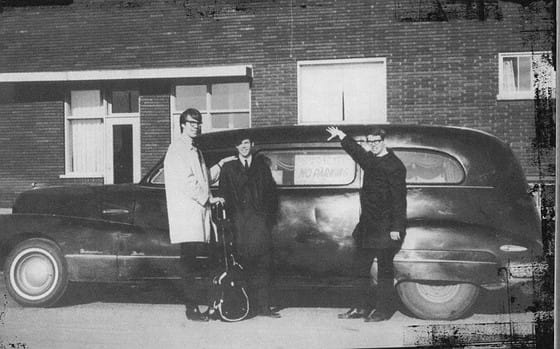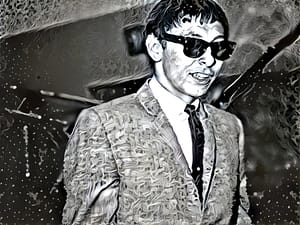Neil Young contains multitudes. Sensitive singer songwriter, grizzled ‘godfather of grunge’, lifelong stoner, model train enthusiast. He’s a contrarian whose style has morphed and changed sometimes dramatically between albums. He’s worked solo. He’s collaborated too, with Buffalo Springfield first then Crazy Horse and most famously Crosby, Stills and Nash. He had and orchestral side he explored with the producer Jack Nitzche.

There’s a rootlessness and vulnerability to the Music of Neil Young. He was born in Canada, travelled round with his dad’s work. One of the last generation to be affected by polio he was almost taken down by the illness.
The sickness along with his moving from town to town separated him from other children, made him different.
His parents divorced right around the time he hit his teens and a few years later he went over the border to the US. There he was part of the first mixed race group to sign to Motown Records (the front man? why it was Rick James the ‘Super freak’). Instead of a pickup he bought a hearse and drove it down to LA.

There he got a band together with two Canadian friends and a pair of Americans. They called themselves Buffalo Springfield after a tractor. They made some great sounding records. ‘For What it’s Worth’ hit the charts and Buffalo Springfield caught the mood of the moment. His bandmate Stephen Stills wrote it. Young supplied the song’s signature hook, the bell-like guitar harmonics.
A note, each of the songs titles in this article has a YouTube link. I would have preferred to embed I video under each title. However WMG group doesn’t allow embedding. I have made a YouTube playlist. For obvious reasons there is no Spotify playlist.
Buffalo Springfield-‘Expecting to Fly’
The first full flowering of Neil Young’s song writing talent. This song was recorded in the immediate afterglow of having heard ‘Sgt Pepper’. Jack Nitzche’s orchestration forms a beautiful counterpoint to the plaintive melody. He’d worked with Phil Spector fleshing out arrangements and played keys on Rolling Stones records. They’d go on to be frequent collaborators.
Between them Nitzche and Young built up dreamlike and graceful overdubs, some backwards. This was using state of the art production techniques to paint a widescreen vision. That’s not where Young’s future would lie but this recording for me is magical.
It’s also a song that is personally special to me. It was my point of entry into Neil Young’s talent. I bought a ‘psychedelic years’ compilation* when I was 15 and this track blew me away.
Nitzche had faith in Young’s talent and encouraged him to make a break from Buffalo Springfield. The Springfields success meant that Young was able to sign a solo contract. He spent $17,000 of it on a house overlooking LA (you could do that then). Over the next few years a revolving cast of friends, fellow musicians and actors drifted through his scene.
*This is the compilation in question. Great track listing. Start’s with the Byrds’ ‘Eight Miles High’. It covers bubble gum sunshine psych like the lemon pipers through garage bands like the 13th Floor Elevators and even finds room for the Velvet Underground’s theatrically sleazy ‘Venus in Furs’ (stretching the definition of psychedelia certainly but a great track).
Neil Young-The Old Laughing Lady

Neil’s first solo album was his last real multi-tracked affair. The album version was again arranged by Jack Nitzche, drums by the great Earl Palmer. A choir including Merry Clayton and Gloria Jones. It’s an amazing sounding record in itself. There are shades of 60s soundtracks and David Axelrod. The problem is that the production just doesn’t quit sit right with Neil Young as a part of it. It sounds overwrought. Buffalo Springfield records like ‘Broken Arrow’ lent themselves to complex productions. Young’s own work would be much more intimate.
Perhaps the central appeal of Neil young is the fragility of his sound. Notes crack and intonation is sometimes Shakey. This humanity translates best in a naturalistic audio setting. In the studio Young didn’t make this connection until his second album.
In a live setting he was performing regularly, unplugged in the folk tradition. At the guitar or piano he would sing his songs solo. Playing live like this emphasised that vulnerability, let audiences get to know him intimately.
Flying on the Ground Is Wrong (Live at the Cellar Door)
Recorded with Buffalo Springfield On Record it almost sounds like the chamber pop of the Left Bank or Millennium. It’s chock full of hooks, clever transitions between sections. Neil Young’s song writing chops had been building by the day. He’d been uncertain of his voice, reluctant to record solo for ‘Expecting to Fly’. Instead for songs like this Buffalo Springfield again modelled themselves on the Beatles by crafting backing vocal arrangements.
Here, live at the Cellar Door you hear Young’s voice naked accompanied by a nine foot Steinway. The extended spoken introduction gives a taste of the personality behind the music too. He amiably rambles for over 3 minutes here before actually playing the song. You can hear how red his eyes are for the duration.
And dope, namely weed, is the subject matter of the song itself. Neil Young’s long time toking habit has not gone uncommented, mostly by himself. His autobiography ‘Waging Heavy Peace’ abounds with references to ‘numbers’ and strains. This honesty almost cost him his naturalisation papers to finally become an American in 2020.

Another thing that was going on in his life at this point was epilepsy. He’d had a few seizures, they’d shocked him but not so much he abstained from substances. In later years he’d say that he felt his distinctive lead guitar style stemmed from an attempt to control his epilepsy.
Neil Young and Crazy Horse-Birds (mono)
Crazy Horse came on the scene around the Time Neil was looking for direction. The direction Neil chose was recording live. Overdubbing hadn’t been working for him, the records sounded sterile and lifeless. Crazy Horse were a tough group of guys and between them built up a decent head of non-virtuosic steam. They knew how to harmonise, having grown up singing Doo Wop.
They too were looking for a break. Sly Stone had produced a single for them in San Francisco. It had flopped and now the Rockets, as they were called, moved to LA. This brief alternate version shows off the sensitive side of Crazy Horse. On stage, and very often in the studio they were a much louder proposition.

Neil Young and Crazy Horse-Down By The River (Live at the Fillmore East 1970)
Live, theirs was a smoky, in the pocket brand of garage rock. It fitted like a glove with Young’s vulnerable voice and distinctive guitar style. They would hit a groove that begged repeating for hours on end. On lead guitar, Young would trade solos with the band for extended jams. Crazy Horse were always ‘in the pocket’. Jack Nitzche is back again, here on keys for this live performance.
In particular Nitzche was impressed by Danny Whitten, the leader. Whitten was a great guitarist, his timing was impeccable. He was a great songwriter too. His ‘I don’t want to talk about it’ was a hit for multiple artists.
According to Young’s autobiography he wrote this, ‘Cinnamon Girl’ and ‘Cowgirl in the Sand’ in one day. A day he happened to be running a high fever. When life sends Neil Young lemons he makes lemonade.
Neil Young-Don’t Let it Bring You Down
1970s ‘After the Goldrush went top ten. The same year he joined forces with Crosby, Stills and Nash and they found massive commercial success. Stills, was of course Stepehen Stills who had been a member of Buffalo Springfield.
There was a party scene going on around him, cocaine was increasingly racked out on coffee tables. On the down low some were becoming junkies. In her autobiography ‘Girl in a Band’ Kim Gordon of Sonic youth remembers a friend called Bruce Berry. He was a good kid by all accounts but got into heroin. Crime became the way he supported his habit. He overdosed. Both his and the death of Crazy Horse’s guitarist would affect Young deeply.
This was the period of Neil Young’s greatest commercial success. Instead of the middle of the road he would choose to drive himself towards the ditch at the side.